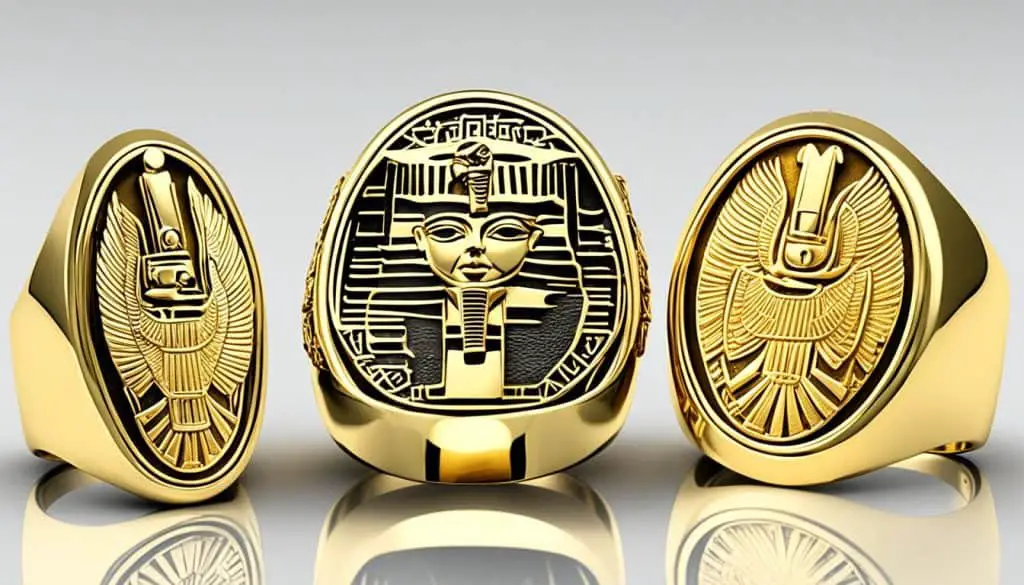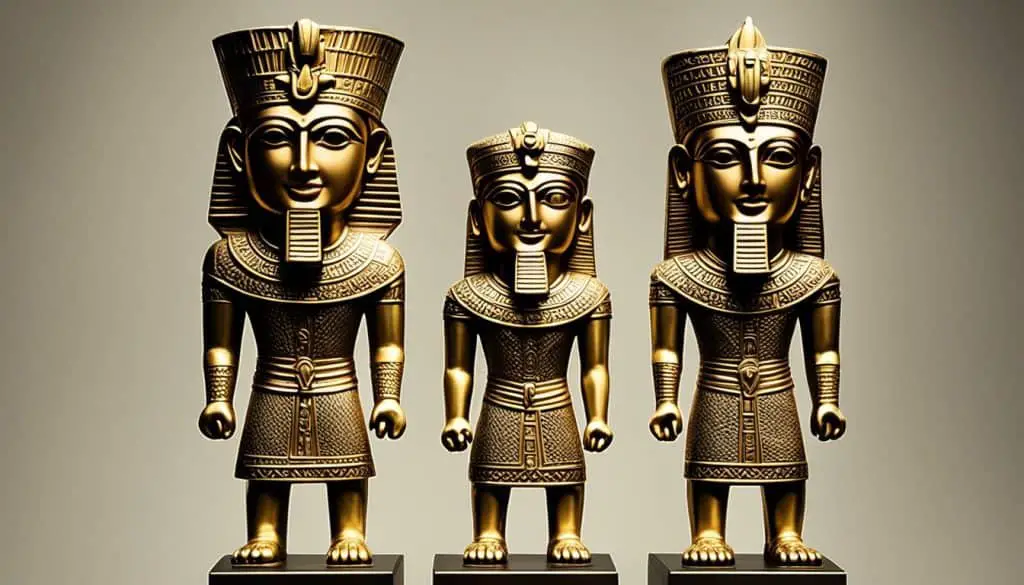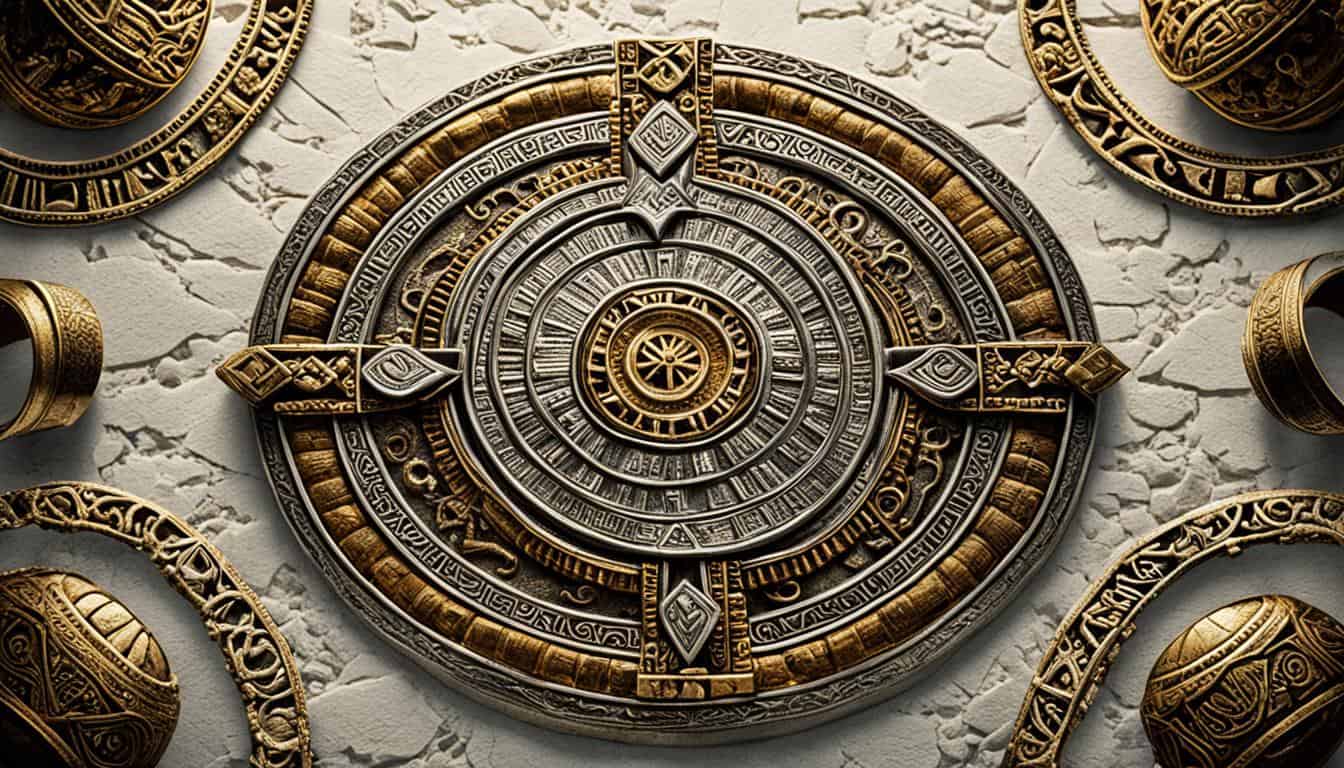Table of Contents
Ever thought about foreign artifacts in the Bible? These items are not just old; they’re also spiritually important. They range from golden earrings to Babylonian idols. Each one shows us a bit of ancient life and history, linking it to events in the Bible. By exploring these artifacts, we learn about their stories and their impact then and now.
Let’s go on a journey to find out more about these hidden treasures. Get ready to see the amazing history they show. We’ll see how the Bible is connected to people all over the world.
Earrings of Gold (Genesis 31:30-32)
Rachel, the wife of Jacob, took earrings of gold from her father, Laban. These earrings were likely from another country. She hid them, causing trouble when Laban accused Jacob.
Laban was not happy when he found out Jacob left quickly. He said he would have said goodbye properly. Jacob denied wronging Laban and let him check his things for anything stolen.
Rachel kept the earrings in her things. Laban found them while looking through Jacob’s and his wives’ stuff. These golden earrings were not just valuable. They were a sign of wealth and showed cultural sharing between Laban’s and Jacob’s families.
“Now you have gone away because you longed greatly for your father’s house, but why did you steal my gods?” – Genesis 31:30
“Now it was not with me when you searched through all my goods, nor will you find anything that belongs to you among all my belongings.” – Genesis 31:32
The gold earrings play a key role in Genesis’s story. Laban thought they were linked to his idols. This hint spices up the plot, pointing at deeper cultural and religious backdrops.
Gold earrings weren’t just about looking good. They showed off rich status and connection to an ancient society’s culture.
Symbols of Affluence and Cultural Exchange
In Genesis, the mention of earrings of gold points to a bigger picture. They stand for Laban’s wealth and the friendly exchange between his family and Jacob’s. These earrings are proof of ancient societies mingling and influencing each other.
Looking closely at these earrings reveals much. They tie Laban’s Mesopotamian roots with Jacob’s Canaanite past. This shows the daily life and connectedness of the Bible’s characters.
Babylonian Garments (Joshua 7:21)
One notable foreign item in the Bible is the Babylonian garment, or the “Shinar cloak.” Achan, an Israelite soldier, took this rich garment from Jericho against God’s order. This move caused the Israelites to lose to their enemies. Achan’s theft showed the power and lure of the fine Babylonian silk. Sadly, it led him down a wrong path.
The allure of the Babylonian garment’s fine craftsmanship and luxurious materials tempted Achan, leading him astray from the path of obedience and righteousness.
This special Babylonian garment caught Achan’s eye. To get why it was so tempting, let’s look at ancient Babylonia. It was a strong empire with great textiles and fashionable clothes.
In Babylonia, garments weren’t just clothes; they showed social status, wealth, and culture. Babylonians loved their clothes and used top-notch fabrics and designs. This helped them show off their luxurious life.
Achan being tempted by the garment shows how powerful foreign cultures’ wealth can be. It shows the battle between the Israelites’ faith and the draw of rich, fancy things.
The Historical Significance of Babylonian Garments
Mentioning Babylonian clothes in the Bible helps us understand this time in history. Babylonia was a big deal then, with lots of money and connections to other places.
The Babylonian garment in Jericho symbolized Babylonia’s conquest. This was a big deal for the Israelites. It was a sign of the power struggle between the two groups and their actions’ results.
The Symbolism of the Shinar Cloak
The Babylonian garment wasn’t just fancy. It stood for the dangers of not following God’s rules, and the need for faith and obedience to Him.
Achan’s story with the cloak warns us about greed and losing sight of important spiritual matters. It asks us to think about what’s really important and our life choices.
In the end, the Babylonian garment story teaches a lesson. Real wealth and joy come from connection with God and leading a good life.
The Shinar Cloak in Historical Context
To truly understand the Shinar cloak, we need its background in the ancient Near East. The Babylonian Empire, based in Babylonia, was known for its power, riches, and way of life.
The image below gives a peek into how amazing Babylonia’s clothes were. It shows the detailed designs and expert craft in Babylonian garments.

| Babylonian Garments | Characteristics |
|---|---|
| Materials | Luxurious fabrics such as fine silk, linen, and wool |
| Designs | Intricate patterns, vibrant colors, and detailed embroidery |
| Social Significance | Symbols of wealth, power, and cultural identity |
| Craftsmanship | Exquisite workmanship, reflecting the advanced textile industry of Babylonia |
This table shows the special features of Babylonian clothes. It highlights their importance and charm during ancient times.
As we study various old items in the Bible, the Babylonian garment reminds us to value our spiritual beliefs. It warns against being too drawn to wealth and to follow God’s rules firmly.
Median Spoils (Esther 1:6)
At a lavish feast hosted by King Ahasuerus of Persia, the guests marveled at the stunning Median spoils. These rich treasures were brought from lands the Persians conquered, possibly from Media. They showed off Persia’s vast wealth and skill from ancient times.
The spoils demonstrated Persia’s might in winning over lands and collecting riches. They spoke of Persia’s power in the area. King Ahasuerus’ abundant wealth and the authority he held were clear for all to see.
The spoils were more than just signs of power. They showed the blending of Persian and Media’s cultures through trade and conquest. This mix enriched Persia’s own cultural heritage with new artistic techniques and styles.
The spoils included many valuable items like beautiful artworks, precious metals, jewelry, and fabrics. Each piece was a masterpiece, showing the incredible talent of the craftsmen. Those who saw them couldn’t help but be amazed at their beauty.
“The Median spoils were a testament to the splendor of the Persian Empire, showcasing the craftsmanship and cultural exchange between nations. These treasures reflected the opulence and power of ancient Persia, leaving a lasting legacy of artistic excellence and wealth.” – Persian historian
List of Median Spoils:
| Item | Description |
|---|---|
| Golden Chalice | A beautifully crafted drinking vessel adorned with intricate engravings and gemstones. |
| Elaborate Tapestry | A large textile depicting scenes of royal hunting expeditions and courtly celebrations. |
| Jade Amulet | A rare and precious amulet carved from jade, believed to possess protective properties. |
| Enamored Earrings | Exquisite earrings set with colorful enamels, reflecting the rich artistic traditions of Media. |
| Golden Crown | A regal crown adorned with gemstones, symbolizing the sovereignty of the Persian Empire. |
The Median spoils truly represented ancient Persia’s wealth and magnificence. They showed off their culture, the gains from their conquests, and their fine craft. These treasures were a window into King Ahasuerus’ rich world and the story of Media.
Egyptian Signet Ring (Genesis 41:42)
Joseph was promoted to Pharaoh’s second-in-command after explaining Pharaoh’s dreams. As a sign of his new authority, Pharaoh gave Joseph his signet ring. This ring was not only a symbol of power but also showed the great importance of Joseph’s role in Egypt.
Joseph’s story in Genesis features the Egyptian Signet Ring prominently. It was a mark of Joseph having the power to represent Pharaoh. This special ring was a clear sign of Joseph’s high position and the heavy-duty he had.
The Egyptian Signet Ring bestowed upon Joseph by Pharaoh not only elevated him to a position of power but also served as a powerful symbol of his authority and influence in ancient Egypt.
The Egyptian Signet Ring symbolized Joseph’s incredible journey from slavery to leadership. This ring was proof of Joseph’s insight and dream interpretation skills. It marked his change from prisoner to Egypt’s main manager during a bad time.
In ancient times, signet rings showed a person’s power and let them seal documents. The mark on the ring showed who the owner was. For Joseph’s Egyptian Signet Ring, it probably showed Pharaoh’s seal, giving Joseph royal power.
The story of the Egyptian Signet Ring goes beyond the Bible. It teaches us about ancient Egypt’s customs and leadership. This ring showed Pharaoh trusted Joseph and knew he was wise and honest. It also shows how Egypt respected its social order and the duties of its royal advisers.
The Role of the Egyptian Signet Ring:
The Egyptian Signet Ring meant a lot in Joseph’s time. It did several key things:
- It showed Joseph was trusted by Pharaoh to run Egypt well.
- The special mark on it was Pharaoh’s, making any document Joseph sealed official.
- With the ring, Joseph could use Egypt’s wealth to help manage things better.
This Egyptian Signet Ring image shows Joseph’s high role and Egypt’s great power too. It makes us think about the deep cultural, historical, and spiritual parts of Joseph’s story in Egypt.
| Symbolism | Cultural Significance | Historical Context |
|---|---|---|
| Power and Authority | Reflection of hierarchical society and respect for royal advisers | Reveals ancient Egypt’s power structures and governance practices |
| Official Seal | Recognition and validation of Joseph’s decrees and decisions | Highlights the administrative practices of ancient Egypt |
| Access to Resources | Efficient execution of administrative duties and management of the kingdom | Illustrates the wealth and prosperity of Egypt during a time of famine |
Queen of Sheba’s Gifts (1 Kings 10:2)
The Queen of Sheba’s visit to see King Solomon was a huge event. She showed off her kingdom’s richness, and Solomon’s wisdom. As 1 Kings 10:2 tells us, she gave Solomon gifts like gold, spices, and gems. These showed the wealth and culture of her kingdom. They were also important for diplomacy.
The gifts from the Queen and Solomon helped their friendship. It showed how much she respected Solomon. The presents were not just things. They were proof of their strong bond and shared beliefs.
The gold she gave was a sign of wealth and power. It showed she saw Solomon as a great king. The spices symbolized luxury and mixed into food brilliantly. They were also used in healing and rituals.
The gems proved the Queen’s land was rich and skilled. Diamonds, emeralds, and rubies illustrated power and beauty. These stones had a big value.
The gifts from the Queen were more than just items. They were about respect and creating a lasting friendship. With these gifts, the Queen shared her kingdom’s success and wished for good ties with Solomon’s land.
This gift exchange was deeply meaningful. It shows how important giving and receiving gifts was back then. Their high value meant they could help in making friends and keeping peace.
Queen of Sheba’s Gifts Table
| Gift | Symbolism |
|---|---|
| Gold | Wealth, Power, Royalty |
| Spices | Luxury, Exoticism, Refinement |
| Precious Stones | Beauty, Rarity, Prestige |
This table breaks down the meaning behind the Queen of Sheba’s gifts. It shows how their presents stood for deep connections and friendship between the two lands.

Babylonian Idols (Daniel 3:1)
In Babylon, during King Nebuchadnezzar II’s rule, a big trial for Daniel and his friends occurred, sparked by the king. He demanded everyone worship a golden idol. This act challenged their faith and showed the cultural and religious ways of Babylon. Despite the risk, Daniel and his friends stayed loyal to their God, refusing to worship idols.
Idols were key to the Babylonians’ religion. These objects, like the golden idol, were seen as ways to connect with their gods. Worshiping them was crucial to Babylon’s culture and belief systems. It wasn’t just a habit; it was a deep part of their spiritual ways.

Daniel and his friends were faced with obeying the king or sticking to their faith. When put to the test, they stood firm. They chose not to worship the golden idol, no matter the cost. Their courage and faithfulness inspired people then and now.
Recorded in the book of Daniel, this story underlines the value of staying faithful. It shows the struggle when cultures and faiths clash. Yet, it also highlights how strong faith can help resist temptations. The Babylonian idols symbolized more than things to worship; they embodied the challenges of faith and belief over time.
Outlining the Significance:
Historical Significance
- It brings out the Babylonian culture and religious practices under Nebuchadnezzar II’s rule.
- Shows the brave stance of those who held onto their faith despite difficulties.
Religious Significance
- It shows the significant role of idols in Babylon’s rituals.
- Inspires through the strong faith of Daniel and his friends.
| Key Takeaways |
|---|
| The Babylonian idols, including the golden idol erected by King Nebuchadnezzar II, represented important religious and cultural symbols in Babylonian society. |
| Daniel and his companions’ refusal to worship the Babylonian idols demonstrated their unwavering faith and commitment to their own beliefs, despite the consequences they faced. |
| The story of the Babylonian idols serves as a reminder of the clash between different cultures, belief systems, and the enduring power of faith in times of adversity. |
How Did the Artifacts from Foreign Empires Influence Biblical History?
The 7 empires impacting biblical history, such as Mesopotamia, Egypt, and Rome, left behind artifacts that influenced the cultural and religious landscape of the ancient Israelites. These artifacts provide valuable insights into the interactions and exchanges between foreign empires and the development of Biblical history.
Conclusion
Foreign artifacts in the Bible peek into ancient civilizations’ historical and cultural sharing. These items, in different Bible stories, are both historical and spiritually meaningful. They help us see the bigger picture of ancient times and biblical stories. By studying these artifacts, we appreciate our rich history and its link to spirituality.
The Bible’s foreign artifacts show how different cultures shared with each other. For example, from Rachel taking gold earrings to Nebuchadnezzar II setting up Babylonian idols. We see the mix of cultural ideas and understand the history better.
These foreign items aren’t just old; they are also spiritually important in the Bible. Think of Joseph’s Egyptian ring for power or the Queen of Sheba’s gifts to Solomon. These objects have strong spiritual messages that still speak to people today.
Summing up, foreign artifacts in the Bible tell us a lot about ancient cultures and their interactions. They share the story of cultural sharing and spiritual lessons found in the Bible. Studying these artifacts deepens our biblical and historical understanding. It also shows the strong link between our history and spiritual beliefs.




